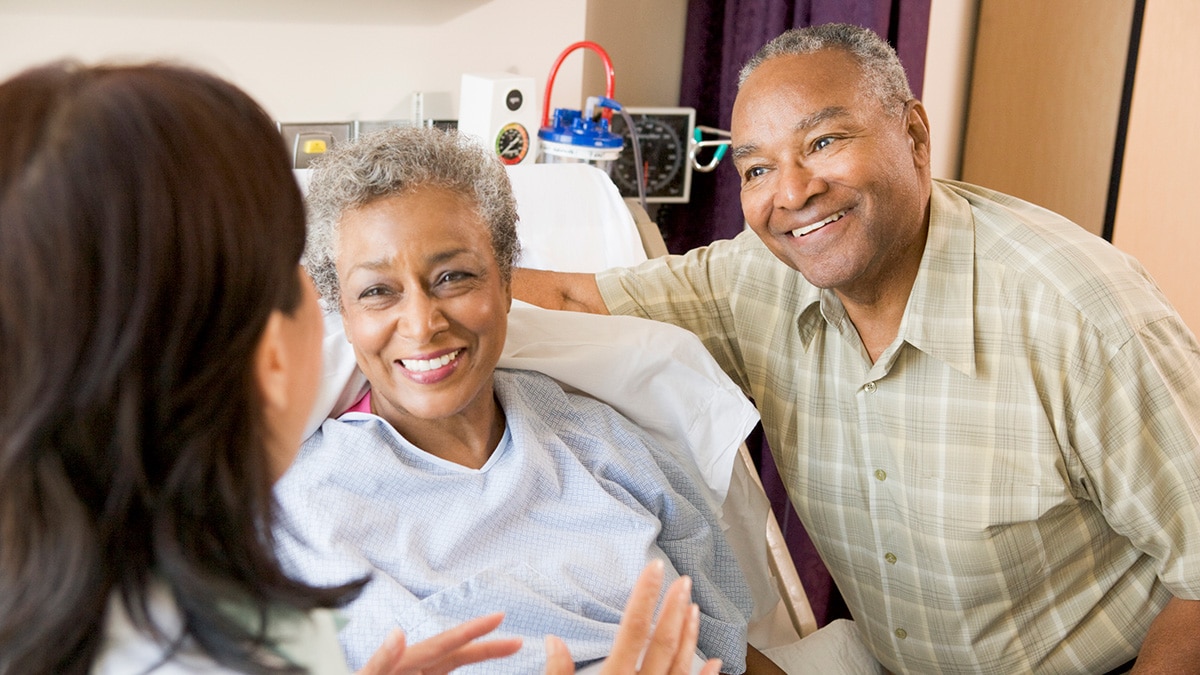Key points
- While everyone is at risk for developing a blood clot, having cancer and some of its treatments increase the risk
- Certain types of cancer and treatments that include hospitalization, surgery, chemotherapy, hormonal therapy, and catheters are associated with increased risk for blood clots
- Know the signs and symptoms of blood clots and discuss your risk with your cancer doctor

Overview
If you currently have cancer or are being treated for cancer, it is important to know that you are at increased risk for developing a blood clot (also called venous thromboembolism or VTE). The good news, though, is blood clots are often preventable and treatable.
While everyone is at risk for developing a blood clot, having cancer and some of its treatments increase the risk for a blood clot. Learn other facts about blood clots below.

Cancers and treatments that can increase risk
Some cancers pose a greater risk for blood clots, including cancers involving the pancreas, stomach, brain, lungs, uterus, ovaries, and kidneys. Certain blood cancers, such as lymphoma and myeloma, also increase risk.
Treatments for these cancers involving hospitalization, surgery, chemotherapy, hormonal therapy, and catheters (small tubes placed in veins to administer treatments) may also increase your risk for blood clots.
Several other factors may also increase the risk for a blood clot in a person with cancer or being treated for cancer, such as
- A previous blood clot
- An inherited blood clotting disorder
- Family history of blood clots or inherited clotting disorder
- Hospitalization for illness or major surgery, particularly those involving the pelvis, abdomen, hip, or knee
- Broken bone or severe muscle injury
- Severe physical trauma, such as a motor vehicle accident
- Certain long-term medical conditions, such as heart and lung diseases or diabetes
- Sitting too long, such as traveling for more than 4 hours, especially with legs crossed
- Other causes of immobility, such as extended bedrest
- Overweight or obesity
- Smoking
Protecting yourself from blood clots during cancer treatment
Know the signs and symptoms of blood clots. Discuss your risks with your cancer doctor.
A blood clot occurring in the legs or arms is called deep vein thrombosis (DVT). Signs and symptoms of a DVT include
- Swelling of the affected limb
- Pain or tenderness not caused by injury
- Skin that is warm to the touch, red, or discolored
If you have the signs or symptoms of a DVT, alert your cancer doctor as soon as possible.
A blood clot in the legs or arms can break off and travel to the lungs. This is called a pulmonary embolism (PE) and can be life threatening. Signs and symptoms of a PE include
- Difficulty breathing
- Chest pain that usually worsens with a deep breath or cough
- Cough or coughing up blood
- Faster than normal or irregular heartbeat
Seek immediate medical attention if you experience any of the signs or symptoms of a possible PE.
Talk with your cancer doctor and other healthcare providers about factors that might increase your risk for a blood clot. Let them know if you or anyone else in your family has ever had a blood clot.
CDC's work in blood clots and cancer
Public health monitoring
In 2018, CDC funded the Association of University Centers on Disabilities (AUCD) to determine the number of people with cancer newly diagnosed with VTE in two U.S. populations: 1) Oklahoma County, Oklahoma and 2) three Duke-affiliated hospitals. AUCD provided funding to researchers at Duke University and the University of Oklahoma Health Science Center to evaluate, analyze, and share information on cancer-associated VTE in these populations. The findings of this project have provided valuable information about the burden of cancer-associated VTE in these populations, as well as how VTE is being identified and treated. Data from studies such as these are needed to improve health care outcomes for people with cancer.
Health promotion and education
The National Blood Clot Alliance (NBCA) in collaboration with CDC developed a digital public health education campaign called Stop the Clot, Spread the Word® to help address the lack of information on blood clots.
Stop the Clot, Spread the Word® was one of many CDC resources recognized in 2017 as an important asset in a collection of VTE educational resources published by The Joint Commission. [PDF – 3.24 MB] The Commission accredits and certifies nearly 21,000 healthcare organizations in the United States.
The campaign web portal provides people with lifesaving information about blood clots, including the factors that increase the risk for blood clots, as well as their signs, symptoms, and prevention.
Campaign digital content is provided in ways that make it easy for you to share with friends and family and across your social media networks. You can access these resources either from the campaign web portal or directly through the links provided below:
Campaign video
This video shares important information about blood clot signs and symptoms, as well as the risk factors for blood clots for people who are being treated for cancer.
Campaign infographic
This infographic shares important information about blood clot signs and symptoms, as well as the risk factors for blood clots in people who are being treated for cancer.
Campaign checklist
Download these checklist to learn more about your risk for blood clots and how to guide a discussion with your cancer doctor.
